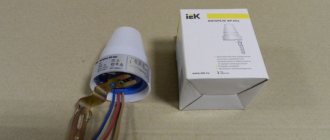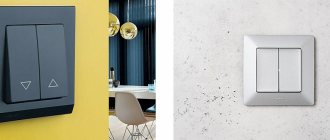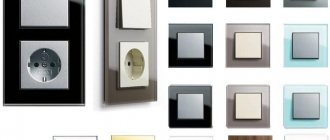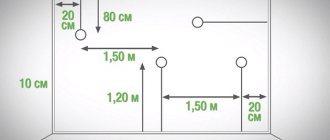Installing a lighting system in a building requires considerable financial and labor costs. At the same time, open cable routing worsens the appearance of the interior, while at the same time, to install hidden wiring, it is necessary to form grooves in the walls and drill sockets for the component elements. Particular difficulties arise if it is necessary to install additional lamps after completing renovations in a room. The best solution to this problem is to purchase a modern wireless switch. It allows you to remotely control the light, adjust its brightness, and set a delay for the operation of electric lamps.
Wireless switch - a device designed for remote control of lighting Source werkel-kupit.ru
Varieties
Modern wireless light switches are classified according to the following criteria:
- Number of controllable luminaires. There are wireless devices designed for one or more groups of lighting fixtures with different numbers of bulbs.
- Possibility of adjusting the luminous flux. The brightness of the lighting is adjusted by long pressing the button of the mechanism with a built-in dimmer.
- Management method. In stores there are designs with convenient touch or push-button switches and remote controls.
Using auxiliary functions allows you to configure the delay of command execution for some time. Then, before the lights go out in the room, the user can perform a number of necessary actions.
With remote control
Simultaneously with stationary switches, remote control of individual, multiple lamps is carried out from an ordinary key fob or remote control. At the same time, 2 buttons are allocated to each channel of the latter: one turns on the electrical power and increases the brightness of the light, the second reduces the light intensity and turns off electrical appliances.
Switching the load on and off is done by briefly pressing the button, and adjusting the light flux is done by holding it down for more than one second. The factory kit usually contains parts for wall mounting.
The presence of a remote control allows you to control the lighting in the house without going to the switches, without pressing them Source elektrikexpert.ru
Touchpad
It is a screen made of crystal glass. It has an image with a visualized backlight. Typically, switching is carried out by briefly applying a finger, lighting control is carried out by holding the latter on the marked area of the panel.
Subsequently, when a person touches the surface of the device, the parameters of the capacitor in the electric field change and a control signal is produced. It triggers the switching circuit of the switch. The absence of mechanical elements in such a design increases the reserve of its functioning to one hundred thousand inclusions.
The touch panel of the wireless switch is activated after lightly touching its surface Source ixbt.online
Multi-channel radio switch
Up to eight channels can be configured, all of them connected to one lighting system. Such a device makes it possible to regulate the light in all rooms of the building. It remembers the addresses of specific remote controls and executes commands only at the individual bitrate.
This design transmits and receives information at a specific speed (measured in kbit/s), and the signal frequency (about 35 kHz) does not change at all. The basis of any remote control is a pulse generator. Its notification is modulated by a specific indication code.
The range of the wireless radio switch is up to 250 meters, the battery charge is designed for 5-7 years of active operation Source bt-energy.ru
What does the market offer?
A wide range of wireless remote switches allows you to choose a product based on price, characteristics and appearance.
Below we consider just a few models that the market offers:
- Fenon TM-75 is a remote-controlled switch made of plastic and designed for a voltage of 220 V. The features of the device include the presence of two channels, a 30-meter range, the presence of a remote control and a delay switch function.
A group of lighting fixtures can be connected to each channel and controlled. The Fenon TM-75 wireless switch can be used with chandeliers, spotlights, LED and track lights, as well as other devices operating on 220 Volts. - Inted 220V is a wireless radio switch designed for wall mounting. It has one key and is installed in conjunction with the receiving unit. The operating voltage of the product is 220 Volts, and the range is 10-50 meters. The wireless light switch is attached using self-tapping screws or double-sided tape. The body is made of plastic.
- INTED-1-CH is a light switch with remote control. With this model you can control light sources remotely. The power of the lamps can be up to 900 W, and the operating voltage of the product is 220 V. Using a radio switch, you can control the equipment, turn on and off the lights or alarms. The product is based on a receiver and transmitter. The latter has the form of a key fob, which is small in size and transmits a signal over a distance of up to 100 m. The product body is not protected from moisture, so additional protection must be provided when installing outdoors.
- Wireless touch switch controlled via remote control. The product is mounted on the wall, has small dimensions and is made of tempered glass and PVC. The operating voltage is from 110 to 220V, and the rated power is up to 300 W. The package includes a switch, remote control and bolts for attaching the accessory. The average life cycle is 1000 clicks.
- Inted 220V 2 Receiver - Wireless Light Switch for Wall Mounting. Control is carried out using two keys. The body is made of plastic. The operating voltage is 220 V. The number of independent channels is 2.
- BAS-IP SH-74 is a wireless radio switch with two independent channels. Control is carried out using a mobile phone on the Android operating system. To work, you must install the BAS application. The SH-74 model is used to control incandescent lamps with a power of up to 500 W, as well as fluorescent light bulbs (power limit - 200 W).
- Feron TM72 is a wireless switch that controls lighting at a distance of up to 30 meters. The light sources are combined into a receiving unit, and switching on and off is done using the remote control. The TM72 model has two channels, each of which can be connected to a specific group of devices. The product has a large power reserve per channel (up to 1 kW), which allows you to connect different types of light sources. The big advantage of the model is the presence of a delay ranging from 10 to 60 seconds.
- Wireless 3-channel switch 220V Smartbuy is designed for connecting light sources into three channels with a power limit of up to 280 W. The rated supply voltage is 220 V. Control is carried out from the remote control, which has a range of 30 meters.
- Z-Wave CH-408 is a wall-type radio switch that allows you to program various scenarios for controlling lighting devices. If necessary, up to eight switches can be connected to it. Among the additional features, it is worth highlighting the management of Z-Wave devices (up to 80) and ease of configuration regardless of the main controller. The device is powered by two batteries, and when they are low, a corresponding signal is given. Firmware updates are performed via the Z-Wave network. The maximum distance to the controller should not exceed 75 meters. Protection class - IP-30.
- Feron TM-76 is a wireless light switch that is controlled remotely using a radio signal. The receiver connects to light sources, and the remote control controls the receiving unit at a distance of up to 30 meters. The Feron TM-76 model has three independent channels, each of which can be connected to its own group of lighting fixtures. In this case, control will be carried out separately, using the remote control. The maximum power reserve is up to 1 kW, which allows you to connect various types of lamps (including incandescent). The operating voltage is 220 V.
Advantages and disadvantages
As practice shows, a wireless light switch is an extremely convenient design. Among its main advantages it is worth noting:
- simple installation that does not involve disturbing the finishing of the walls, chipping their surface, or laying additional wiring;
- the ability to control all lighting fixtures in the home using one control panel;
- large signal reception radius: 30-250 m, which depends on the product model, layout, load of furniture in the room;
- safety for residents: the device operates at a minimum current and in any case is not capable of harming human health.
The disadvantages of wireless devices include loss of control of the lighting system when the battery in the remote control is discharged or the Internet is disconnected (if WI-FI is used).
Wireless switches have no physical connection to switching units at all Source i.siteapi.org
Design and principle of operation of the main elements of the device
The wireless switch consists of the following elements:
- The receiver is a special radio relay that is controlled by a remote control, using a phone with access to Wi-Fi, or directly from a switch. After receiving the signal, the relay closes or opens the contacts. The product is mounted as close as possible to the light source or inside it (if the appropriate dimensions are available).
If we are talking about a spotlight, installation is carried out in a junction box or in the cavity between the main ceiling and the tension fabric. - Transmitter (switch). This device includes a small generator that generates electricity when you press a remote control button, touch a switch, or send a signal from your phone (when controlled via Wi-Fi). The electrical impulse is converted into a radio signal, which is picked up by the receiver. The transmitter can be installed directly into the wall. In this case, there is no need to connect wires to it, because power is supplied from the built-in elements. Thanks to this feature, you can save time on installation and not open the walls. In this way, a transition switch is made that allows you to control the lighting from different points and not have to look for the remote control.
Application
It is advisable to purchase and then install wireless switches (instead of traditional devices), if necessary:
- Turning lights on or off at great distances. Installation of wiring is expensive, the radio switch (depending on the product) operates within a range of no more than 350 meters.
- Transferring any device. In order not to move bulky furniture and to avoid damaging the finish, the device can be installed on the wall, inside the cabinet.
- Elimination of installation defects. When moving the power line, there is no need to trench the walls; it will be enough to connect the mechanism with or without a remote control.
- Ensuring convenient use of electrical appliances. The contactless switch does not take up much space and is easy to operate.
- Control lighting throughout the house. A small functional device with a remote control provides the ability to control connected light sources from several zones.
- Saving the design idea. If the switch cannot be installed inside a niche, the wireless device will fit perfectly into any interior style.
Important! In wooden buildings, when flammable building materials are used inside the buildings, the laid cable significantly increases the likelihood of a fire. The use of distance structures will be the most economical and simple solution.
Modern wireless switches have a stylish appearance and can be installed within a few minutes Source elektrikexpert.ru
Subtleties of choice
When choosing a device, you should consider some important characteristics. Among them:
- the type of light bulbs that the device can control;
- dimensions;
- appearance of the device (case color, material, shape, for mechanical ones - number of keys/buttons);
- operating voltage;
- wireless technology;
- number of interface channels;
- signal coverage radius, ability to work through repeaters;
- maximum operating load;
- rated current;
- operating frequencies;
- presence/absence of encryption;
- way of eating;
- type of control (buttons, remote control, sensor, all of the above);
- possibility of remote control from a smartphone, tablet or personal computer;
- if integration into a “smart home” is planned – the presence of such a function and supported intelligent systems;
- battery life declared by the developer;
- fastening method;
- price.
As you can see, it is advisable to start selecting a wireless switch already at the design stage of the room in order to buy the most suitable sample for specific conditions. But if a gadget is bought for a ready-made and finished house, room, or commercial property, the first place comes to cost-effectiveness, compactness, versatility and inconspicuousness (or a design that matches the interiors).
In addition, it is important to have a factory warranty and manufacturer service centers. They will make it easier to repair or replace a faulty device.
What to look for during the selection process
Before you begin selecting a wireless switch, you should determine the number of lamp groups that the device will serve. The number of channels can vary from one to eight. Low power consumption of touch and button products in gentle standby mode guarantees long-term operation of the transmitter: battery replacement is not required for two to seven years.
Additionally, it is necessary to calculate the total power of the light sources planned for connection, then accordingly select a device with optimal technical characteristics. It is definitely worth considering that models using infrared rays operate only at a viewing distance of the receiver; at the same time, radio waves can bend around all sorts of obstacles and penetrate walls inside structures. For a private home, there is no need to purchase a transmitter with a maximum power of 10 mW and a range of 0.1 km. In this case, a distance of 30 meters will be sufficient.
Advantages and disadvantages of wireless switches
Despite their ease of use, wireless load switches (in our case, lighting) have not only advantages, but also disadvantages. But more about everything.
Pros:
- Ease of installation. For installation and connection, you do not need to drill into walls or lay a separate “branch” of electrical wiring.
- Possibility to control several light sources at once from the remote control or via a smartphone.
- Large range of action. The control signal in an open area can reach the receiver at a distance of up to 30 meters. In this case, walls or pieces of furniture are not an obstacle.
- Safety for adults and children. Even accidental damage to the structure does not pose a health risk. The operating current in wireless remote switches is minimal and not hazardous to health.
Minuses:
- The cost of such products is higher than classic “wired” switches. Adherents of economy and conservatives prefer familiar products.
- Inability to control due to low battery in the remote control or inability to control due to weak Wi-Fi connection.
How to connect with your own hands
Typically, the dimensions of the receiving module do not exceed the size of a box of matches. Therefore, it is easy to place it in the installation box or other easily accessible places near the installation wires. It can also be mounted at the location of the old switch (the latter must be removed).
To correctly install a wireless switch, you need to use a simple connection diagram Source strojdvor.ru
According to safety precautions, the day before connecting a wireless device, it is extremely important to turn off the electricity at the distribution panel. Connect the device to the electrical circuit in the following sequence:
- Cut the phase wire suitable for the lamp, connect the ends to Lin and Lout (in the case of a single-channel product).
- In a multi-channel model, separate the phase, then connect it to the corresponding light bulbs through the output terminals L1out, L2out, ..., Lnout.
- The common zero N is applied to the lamp lamps through the output and input zero terminals.
The contactless switch can be attached using the following methods:
- For screws into the socket of an old device or into a newly created hole.
- Glue using double-sided tape (usually included in the kit) to facing tiles, wallpaper or any parts in the interior.
The installation process of a wireless switch is practically no different from the installation of a conventional switch, the only difference is that there is no need for wiring Source electrikmaster.ru
Remote switch design
The switch is very easy to disassemble. It is enough to use a screwdriver to pry out the slots at the junction of the cover and the body. There is no need to unscrew any screws.
Inside it is:
- electronic board
- central on/off button
- LED for visualizing the connection between the switch and the radio module
- battery type 27A 12 volt
This battery, even with intensive use, can last 2 years or more. In addition, there is no particular shortage of them at the moment. It may not be included in the package, please keep in mind.
By the way, the switch is initially universal. On the sides of the central button, there are places where you can solder two additional buttons.
And by changing the key itself, you can easily change from a single-key to a two- or even three-key one.
True, in this case you will have to add more modules, according to the number of buttons.
There is a hole on the radio module box. It is intended for a button, when clicked, you can “bind” or “erase the binding” of a particular device.
In terms of radio signal range, the manufacturer claims a distance from 20 to 100 meters. But this applies more to open spaces. From practice, we can say that in a panel house the signal easily penetrates four concrete walls at a distance of 15-20 meters.
There is a 5A fuse installed inside the box. Although the manufacturer indicates that through a remote switch you can connect a load of 10A, which is as much as 2kW!
The diagram for connecting wires to the contacts of the radio module of the wireless switch is as follows:
When connecting, you can also navigate by the labels. Where there are three terminals there is an output, where there are two terminals there is an input.
- L out – phase output
- N out – zero output
Connect the wiring to the light bulb to these contacts. Supply voltage 220V to the two contacts on the other side.
On the side of the output contacts there are three more points for soldering jumpers. By re-soldering them accordingly (as in the figure), you can change the logic of the product:
When the key is pressed, the relay contacts close. When released it will turn off.
This can be used to make a call or to give a short-term signal of some kind. There is also a middle contact “B”. When using it, the switch will operate in inverse mode.
Distinctive features of wireless devices
Modern wireless switches, manufactured under different brands, are similar in design and operating principle.
The devices differ in the following parameters:
- type of control (push-button, touch, remote);
- the ability to control the intensity of the light flux in the room (whether present or not);
- number of devices to be managed (from 1 to 8 depending on the model and manufacturer).
In addition to the above items, there are significant differences in functionality. The majority of devices simply control the switching on/off of lights in rooms.
Only advanced models are equipped with additional features such as:
- response delay - the device is activated or deactivated not immediately at the moment the button is pressed, but somewhat later, for example, while a person is walking towards the bed or to the exit from the room;
- multi-channel control - it is possible to configure several channels, allowing you to turn on several devices at once, even those located in different rooms of the same building;
- touch panel - there are no buttons that can lose sensitivity over time and fail. To activate the equipment, just touch the display;
- availability of Wi-Fi - the extension makes it possible to send a signal through available gadgets such as a smartphone, tablet or computer with Internet access.
The wider the functionality of the device, the higher its cost.
Wireless type switches look attractive, fit easily into the interior and give the decorative design of the room elegance and a stylish, modern look
The premium class includes “smart” wireless switches with a wide coverage radius (up to 350 meters), equipped with an internal energy generator, a touch control panel and the ability to multi-control the lighting system.
Such devices are usually installed in large houses, large apartments or country cottages that have an extensive lighting system. Budget ones include simple battery-powered models. Their coverage area is limited to 20-50 meters, which is quite enough for an average city apartment.
Selecting a Remote Control System
When selecting a device with remote control, you need to pay attention to a number of factors. You should check whether the power of the power unit corresponds to that of the lighting device, as well as the voltage required to power the switch. The latter must match the number of volts in the network to which you plan to connect the remote device.
The design of a modern remote switch that has a number of additional functions: response to moving objects, protection from natural phenomena and others
It is also advisable to evaluate the need for additional functions that models are often equipped with: on the one hand, they significantly expand the scope of application of the device, on the other hand, in specific situations they often remain unclaimed.
Finally, the design of the device, its shape, color, size, the presence of additional lighting, and other factors are of a certain importance.
Voice control of light in an apartment: how sound commands work - 2 approaches
Light control using sounds is based on the use of acoustic sensors. If you don’t go deeply into technical details, then they include an ordinary microphone.
It is built into the design of the switch, must have small dimensions and high sensitivity, allowing you to reliably distinguish voice commands from the many other sounds present in the apartment.
Voice control of light should work reliably in conditions of loud listening to radio broadcasts, music, and sounds from the TV. Even a simple conversation between family members should not be perceived by the acoustic sensor as control signals. It must be reliably built from them.
This function is quite difficult to implement technically. Therefore, simple models of acoustic switches use sharp sound signals that are not typical for a normal environment, for example, loud clapping of palms.
The connection diagram for the voice control module is the simplest. It is mounted in the break of the phase lighting wire anywhere. It is quite convenient to replace with it an ordinary switch located inside an existing installation box.
This method does not require any additional work and should not cause any difficulties.
Voice control of lighting devices is implemented in two methods:
- Without the need for additional settings of the equipment used.
- By entering voice commands into the device’s memory during initial setup during connection.
Especially for the second case, it is convenient to use the Smart Home system and the “Voice Assistant Alice” application specially created for it, which works inside Yandex search. Its English-language counterparts are Amazon Alexa and Google Home.
The application installed on a mobile gadget or computer will need to be connected and configured according to the available instructions once, and then you can use it constantly and practically free of charge.
I would like to immediately note that Yandex Alice is a management system that was put into operation not so long ago. There may still be some glitches in it. But, all these cases must be immediately reported to technical support: it promises to take effective measures and will help in a timely manner to resolve an issue that accidentally arises.
However, think about what will happen to such voice control when the Internet is turned off, whether it is necessary to create a backup switch.











